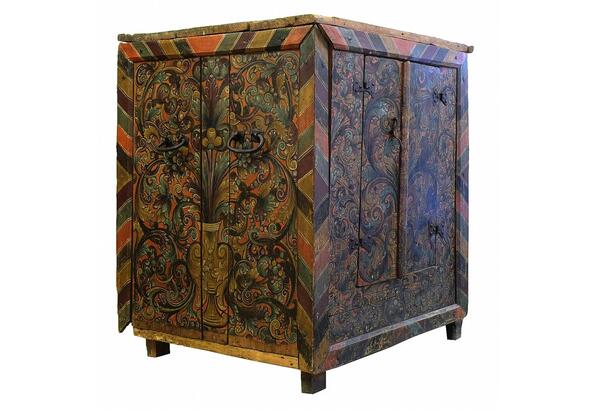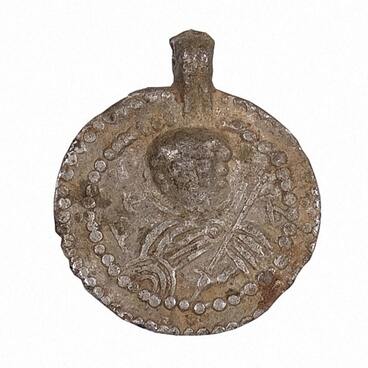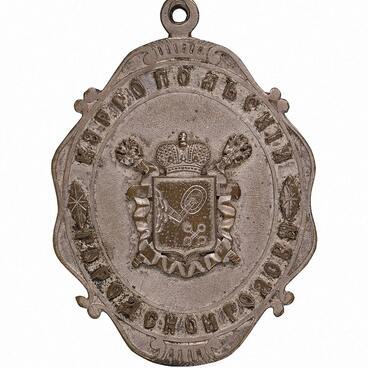The lectern is a high table with a sloping top, which is used in the church to place icons and books. Often such tables are located in church choir galleries, where singers and reciters stand during the service. They perform psalms and prayers, and the choir lectern serves them as a stand for books and music.
The lectern from the museum’s collection used to be in the Church of the Annunciation of the Most Holy Theotokos in the town of Kargopol. An unknown master created it in the form of a cabinet on four low legs. He added swing doors and two pairs of copper handles on the sides so that the item was easy to carry.
Unfortunately, the pyramidal top-stone of the lectern has not been preserved. Therefore, it is shown in the exhibition with a flat unpainted top.
The artist decorated the lectern with a magnificent painting on an orange background: on all four walls, he depicted a yellow rounded flowerpot with an elongated neck. A tree grows out of the flowerpot, the branches of which turn into a pattern of multicolored leaves, buds and large flowers similar to tulips.
The painting is distinguished by a free, baroque whimsical pattern and a coordinated color system. Baroque is an artistic style that became especially popular in Europe of the 17th century and later spread to many countries. It is characterized by contrasts, dynamic images, grandeur and splendor, and ornate drawings.
The coloring of the painting combines golden yellow, reddish-brown, blue and olive colors. The artist skillfully modeled the volumes with light and shadow and also applied whitewash strokes — highlights of white color that mimic flecks of light.
On the inside, the doors are painted with whorls of lush black leaves on a golden yellow background. There was a shelf inside the table, where liturgical books were kept.
The Church of the Annunciation of the Most Holy Theotokos, where the cabinet used to be, was built in the period from 1692 to 1723. The builders erected a two-story temple of calcareous flagstone. The windows were decorated with stone-carved architraves, and strict classic decorations with beaded carvings for the apses (these architectural projections are the place for church altars) were created. All these features distinguish the Kargopol temple from other buildings of the 17th century.
The lectern from the museum’s collection used to be in the Church of the Annunciation of the Most Holy Theotokos in the town of Kargopol. An unknown master created it in the form of a cabinet on four low legs. He added swing doors and two pairs of copper handles on the sides so that the item was easy to carry.
Unfortunately, the pyramidal top-stone of the lectern has not been preserved. Therefore, it is shown in the exhibition with a flat unpainted top.
The artist decorated the lectern with a magnificent painting on an orange background: on all four walls, he depicted a yellow rounded flowerpot with an elongated neck. A tree grows out of the flowerpot, the branches of which turn into a pattern of multicolored leaves, buds and large flowers similar to tulips.
The painting is distinguished by a free, baroque whimsical pattern and a coordinated color system. Baroque is an artistic style that became especially popular in Europe of the 17th century and later spread to many countries. It is characterized by contrasts, dynamic images, grandeur and splendor, and ornate drawings.
The coloring of the painting combines golden yellow, reddish-brown, blue and olive colors. The artist skillfully modeled the volumes with light and shadow and also applied whitewash strokes — highlights of white color that mimic flecks of light.
On the inside, the doors are painted with whorls of lush black leaves on a golden yellow background. There was a shelf inside the table, where liturgical books were kept.
The Church of the Annunciation of the Most Holy Theotokos, where the cabinet used to be, was built in the period from 1692 to 1723. The builders erected a two-story temple of calcareous flagstone. The windows were decorated with stone-carved architraves, and strict classic decorations with beaded carvings for the apses (these architectural projections are the place for church altars) were created. All these features distinguish the Kargopol temple from other buildings of the 17th century.



